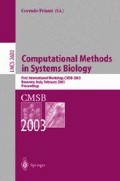Abstract
A graphic language—the graphic κ calculus—modeling protein interactions at the domain level is introduced. Complexation, activation and mixed forms of interaction are expressed as graph rewriting rules. A compilation in a low-level graph rewriting calculus, called mobile κ, is given and shown to be correct up to some suitable notion of observational equivalence. This intermediate language is of independent interest and can be easily implemented in π-like calculi.
Access this chapter
Tax calculation will be finalised at checkout
Purchases are for personal use only
Preview
Unable to display preview. Download preview PDF.
References
Gérard Berry and Gérard Boudol. The chemical abstract machine. Theoretical Computer Science, 96:217–248, 1992. 35
A. Bouali, S. Gnesi, and S. Larosa. JACK: Just another concurrency kit. Bulletin of the European Association for Theoretical Computer Science, 54:207–224, October 1994. Technical Contributions. 35
[3] Marc Chiaverini and Vincent Danos. A core modeling language for the working molecular biologist. Communication to the International Workshop on Computational Methods in Systems Biology, 2003. 34
Vincent Danos and Cosimo Laneve. Core formal molecular biology. To appear in Proceedings of ESOP 2003-European Symposium on Programming, Lecture Notes in Computer Science, Springer Verlag, 2003. 34, 38
Reinhard Diestel. Graph Theory. Springer, New-York, 2000. 41
Steven Eker, Merrill Knapp, Keith Laderoute, Patrick Lincoln, José Meseguer, and Kemal Sonmez. Pathway logic: Symbolic analysis of biological signaling. In Proceedings of the Pacific Symposium on Biocomputing, pages 400–412, January 2002. To appear. 35
Cédric Fournet and Georges Gonthier. The reflexive chemical abstract machine and the join-calculus. In 23rd ACM Symposium on Principles of Programming Languages (POPL’96), 1996. 34, 35
Kurt W. Kohn. Molecular interaction map of the mammalian cell cycle control and DNA repair systems. Molecular Biology of the Cell, n. 10:2703–2734, 1999. 34
H. Lin. An interactive proof tool for process algebras. In Alain Finkel and Matthias Jantzen, editors, Proceedings of Symposion on Theoretical Aspects of Computer Science (STACS’ 92), volume 577 of LNCS, pages 617–618, Berlin, Germany, February 1992. Springer. 35
Robin Milner, Joachim Parrow, and David Walker. A calculus of mobile processes I and II. Information and Computation, 100:1–41, 42-78, 1992. 34, 35
Masao Nagasaki, Shuichi Onami, Satoru Miyano, and Hiroaki Kitano. Biocalculus: Its concept and molecular interaction. Genome Informatics, 10:133–143, 1999. 34
Corrado Priami, Aviv Regev, Ehud Shapiro, and William Silverman. Application of a stochastic name-passing calculus to representation and simulation of molecular processes. Information Processing Letters, 2001. in press. 34
Aviv Regev and Ehud Shapiro. Cells as computation. Nature, 419, September 2002. 34
Aviv Regev, William Silverman, and Ehud Shapiro. Representation and simulation of biochemical processes using the π-calculus process algebra. In R. B. Altman, A. K. Dunker, L. Hunter, and T. E.T Klein, editors, Pacific Symposium on Biocomputing, volume 6, pages 459–470, Singapore, 2001. World Scientific Press. 34
Björn Victor and Faron Moller. The Mobility Workbench-a tool for the π-calculus. In David Dill, editor, CAV’94: Computer Aided Verification, volume 818 of Lecture Notes in Computer Science, pages 428–440. Springer-Verlag, 1994. 35
Pawel T. Wojciechowski and Peter Sewell. Nomadic Pict: Language and infrastructure design for mobile agents. IEEE Concurrency, 8(2):42–52, April/June 2000. 39
Author information
Authors and Affiliations
Editor information
Editors and Affiliations
Rights and permissions
Copyright information
© 2003 Springer-Verlag Berlin Heidelberg
About this paper
Cite this paper
Danos, V., Laneve, C. (2003). Graphs for Core Molecular Biology. In: Priami, C. (eds) Computational Methods in Systems Biology. CMSB 2003. Lecture Notes in Computer Science, vol 2602. Springer, Berlin, Heidelberg. https://doi.org/10.1007/3-540-36481-1_4
Download citation
DOI: https://doi.org/10.1007/3-540-36481-1_4
Published:
Publisher Name: Springer, Berlin, Heidelberg
Print ISBN: 978-3-540-00605-3
Online ISBN: 978-3-540-36481-8
eBook Packages: Springer Book Archive

